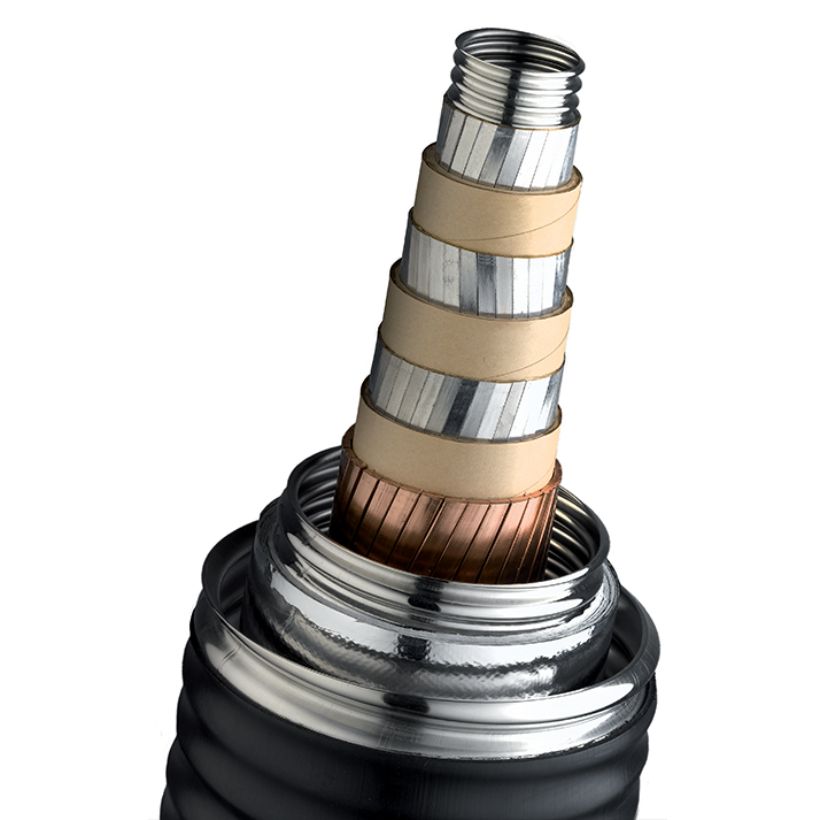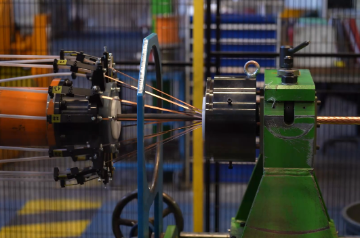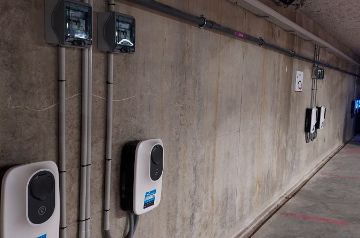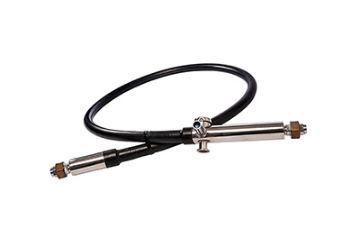- Marchés
- Produits
- Services
- News
- Outils et Ressources
- A propos de Nexans
- Recherche
- Contactez-nous
- Comparer
- Se connecter
Supraconductivité
La supraconductivité : Révolutionner les réseaux énergétiques
20 juin 2025
La supraconductivité était à l'honneur lors de la conférence CIRED qui s'est tenue à Genève en juin 2025. L'accent a été mis sur la manière d'accélérer la transition énergétique, en particulier pour cette édition, et notamment les enjeux liés la quantité de réseaux et de lignes de transmission nécessaires pour soutenir l'électrification et le développement des énergies renouvelables. La technologie supraconductrice s’inscrivait parfaitement dans cette ligne, la supraconductivité change la donne quant au développement des réseaux énergétiques de par son caractère révolutionnaire et le potentiel qu'elle représente pour améliorer la résilience des réseaux d'énergie.
Nexans a été sélectionné pour présenter deux de ses projets de câbles supraconducteurs révolutionnaires. Cette reconnaissance par les comités techniques du CIRED, qui comprend l'acceptation de trois posters et d'une session orale, souligne le leadership et l'innovation de Nexans dans le domaine des câbles supraconducteurs à haute température (HTS) - un élément clé de la modernisation et de la décarbonation du réseau électrique
Articles présentés:
- Article n° 956 - Projet Scarlet : Câbles supraconducteurs moyenne tension pour la transition énergétique de l'Europe
Présentateur: Arnaud ALLAIS
Principaux avantages de la technologie des câbles supraconducteurs MVDC :- Permet de réduire les niveaux de tension exigés tout en maintenant ou en augmentant le transfert d'énergie
- Simplification de l'architecture du système, réduction des coûts globaux
- Conception compacte, pertes énergétiques minimales et encombrement réduit
- Contribue activement aux efforts de normalisation internationale
- Article n° 1159 - Micro-réseau supraconducteur : Favoriser les synergies entre les réseaux d'énergie et les centres de données
Présentateur: Paul Bakhos, MBA, PMP Bakhos
Avantages des câbles supraconducteurs pour les applications à basse tension- Résistance nulle et perte d'énergie nulle
- Pas de chute de tension ni d'émissions de champs électromagnétiques (EMF)
- Conception simplifiée et compacte du système par rapport aux câbles résistifs conventionnels.
- Article n° 967 - SuperRail : une première mondiale en matière de supraconductivité pour l'électrification des réseaux ferroviaires
Présentateur: Yann Duclot
Une étape révolutionnaire pour l'électrification de l'infrastructure ferroviaire à Paris Gare de Montparnasse avec SNCF Réseau:- Ajout d'une capacité de 5,3 MW grâce à deux câbles HTS de 1500V DC @ 3500A
- Permettre l'exploitation de 16 wagons supplémentaires, augmentant ainsi le nombre de passagers à 90 millions par an.
- Réalisé sans modifier l'infrastructure existante, en utilisant deux conduits de réserve pour installer les câbles HTS.
Plus d'information sur la supraconductivité:
La supraconductivité pour accélérer la transition énergétique et l'électrification
La supraconductivité est de plus en plus utilisée dans diverses applications, et présente un potentiel considérable pour remodeler et révolutionner les réseaux de transmission et de distribution d'énergie. L’adoption de câbles supraconducteurs et de limiteurs de courant de défaut contribuent à améliorer l'efficacité et durabilité des réseaux électriques tout en augmentant les capacités de transmission. Ces avancées s’inscrivent parfaitement dans la stratégie globale de décarbonation visant à faciliter la transition énergétique via des systèmes et réseaux plus efficaces.
L'électrification connaît une croissance rapide et joue un rôle important dans la réduction des émissions de CO2, l'amélioration de l'efficacité énergétique, le renforcement de la sécurité des réseaux et la modernisation des infrastructures. Cette évolution est portée par des facteurs économiques, l’innovation technologique et des considérations liées au climat. Le secteur avance à un rythme soutenu, marqué par une intensification notable de ses activités. L'avenir de notre planète dépend de la transition vers les sources d'énergie renouvelables. La question n'est plus de savoir si cette transition aura lieu, mais quand elle aura lieu. La sécurité du réseau électrique devenant de plus en plus critique, il est impératif de mettre en place un réseau électrique durable.
Depuis plus d'un siècle, les réseaux constituent l'épine dorsale des réseaux de distribution électrique pour différents secteurs. L’adoption croissante des véhicules électriques et des pompes à chaleur favorise le remplacement des combustibles fossiles par l’électricité dans de nouveaux domaines, entraînant ainsi une hausse de la demande énergétique. En outre, l'expansion rapide des projets d'énergie renouvelable nécessite davantage de lignes électriques et des réseaux efficaces afin d’assurer la continuité et la fiabilité de l’alimentation électrique.
Avec la transition mondiale vers une électrification accrue portée par le développement des énergies renouvelables, l’essor des véhicules électriques (VE) et l’électrification industrielle, les réseaux de distribution d’énergie font face à des défis majeurs: surcharges du réseau, des retards dans l’intégration des ressources énergétiques distribuées (DER), l’instabilité de la fréquence et l’inadéquation des mises à niveau de l’infrastructure. Autant d’enjeux qui nous amènent à reconsidérer et repenser le fonctionnement des réseaux mondiaux.
3 défis majeurs dans la transition vers les énergies renouvelables
#1. Des réseaux modernes, intelligents et étendus sont essentiels pour réussir la transition énergétique
La transition vers des sources d’énergie renforcent le rôle essentiel des réseaux électriques, au cœur des systèmes électriques modernes. Toutefois, ils sont souvent négligés. Depuis plus d'un siècle, les réseaux alimentent les foyers, les entreprises et les industries. La transition vers les énergies propres transforme nos systèmes énergétiques et accroît le rôle de l'électricité dans les économies. Par conséquent, la réalisation des objectifs de neutralité carbone requiert la mise en place de réseaux électriques plus vastes, plus performants et dotés de technologies avancées.
Afin d’atteindre les objectifs nationaux en matière d’énergie et de climat, la consommation mondiale d’électricité devra croître de 20 % au cours de la prochaine décennie par rapport à la précédente. Pour réussir la transition vers des émissions nettes nulles d’ici 2050 et maintenir l’augmentation de la température sous la barre des 1,5 °C, la demande en électricité devra progresser à un rythme encore plus soutenu. Le développement des réseaux électriques apparaît comme un facteur déterminant pour soutenir cette croissance, notamment avec l’essor des véhicules électriques, des systèmes de chauffage et de refroidissement, ainsi que la production d’hydrogène par électrolyse.
Afin d’atteindre les objectifs nationaux, il est nécessaire d’ajouter ou de rénover plus de 80 millions de kilomètres de réseaux d’ici 2040. Les infrastructures réseau jouent un rôle central dans la décarbonation du secteur électrique et l’intégration des sources d’énergie renouvelable. Si les objectifs énergétiques et climatiques des pays sont réalisés, l’éolien et le solaire photovoltaïque pourraient représenter plus de 80 % de la croissance de la capacité électrique mondiale au cours des vingt prochaines années, contre moins de 40 % auparavant. Selon le scénario « zéro émission d’ici à 2050 » de l’AIE, ces deux technologies compteraient pour près de 90 % de l’augmentation. Ce développement soutenu des énergies renouvelables induit une modernisation des réseaux de distribution ainsi que la création de nouvelles lignes de transmission afin de connecter les sites de production éloignés aux zones de forte demande.
Les réseaux numériques actuels jouent un rôle important dans la gestion de l'électricité notamment dans la transition vers des énergies renouvelables. Avec la hausse de l'utilisation du solaire photovoltaïque et de l'énergie éolienne, les infrastructures doivent s'adapter pour gérer les fluctuations de production. Atteindre les objectifs liés au climat nécessitera une augmentation de la flexibilité des systèmes d'ici 2030 (le double). Cela implique la mise en œuvre de nouvelles opérations sur le réseau pour intégrer des sources d'énergie supplémentaires comme les panneaux solaires, ainsi que l'installation de technologies destinées à améliorer le fonctionnement des réseaux et à répondre aux besoins croissants en énergie et en stockage grâce à la numérisation.
Plus d'informations sur la supraconductivité:

Certaines technologies de réseau innovantes (IGT) sont prêtes, notamment la supraconductivité.
Les systèmes de câbles supraconducteurs ont un rôle essentiel à jouer pour relever ces défis.
Outre leur efficacité énergétique et leur fiabilité, les systèmes supraconducteurs sont plus faciles à installer et occupent beaucoup moins d'espace que les câbles et les lignes aériennes conventionnels. Les opérateurs de systèmes de transmission et de distribution peuvent bénéficier de l'intégration de systèmes de câbles supraconducteurs dans leurs réseaux:
- renforcer la capacité et la résilience des réseaux urbains : les opérateurs de réseaux de distribution recherchent des solutions économiques et peu disruptives en vue d’améliorer l'alimentation électrique des villes. Les câbles supraconducteurs sont capables de transmettre de grandes quantités d'énergie électrique dans un périmètre très réduit - généralement d'un mètre de large seulement. Cela permet non seulement de minimiser les coûts, mais aussi de réduire les perturbations généralement causées par les travaux de génie civil. Un autre avantage est que l'électricité peut être transmise à moyenne tension. Cela permet de déployer des "sous-stations éloignées" dans la périphérie urbaine et d'éviter l’installation de transformateurs à haute tension en centre-ville, ce qui représente une économie substantielle. Par ailleurs, les câbles supraconducteurs facilitent la mise en œuvre d’interconnexion entre les sous-station, renforçant ainsi la résilience des réseaux.
- faciliter la transition énergétique : la décentralisation de la production accroît la nécessité d’augmentation des capacités de transmission: Les systèmes de câbles supraconducteurs permettent de transmettre de grandes quantités d’énergie sur de longues distances, sans les pertes énergétiques caractéristiques des lignes et les câbles à haute tension conventionnels. Les systèmes de câbles supraconducteurs à courant continu haute tension (CCHT) sont particulièrement adaptés à cette application. Nexans a qualifié un câble supraconducteur 320 kV DC pour des courants allant jusqu'à 10 kA avec une capacité de transport d'énergie de 3,2 GW.
news associées
Supraconductivité
27 juin 2024#2. Sécurité et infrastructure des réseaux électriques : les réseaux risquent de devenir le maillon faible de la transition vers les énergies propres
Plus de 3 000 gigawatts (GW) de projets d’énergie renouvelable sont actuellement en attente de raccordement aux réseaux électriques, dont 1 500 GW à un stade avancé de développement, soit une capacité cinq fois supérieure à l’ensemble de la production solaire et éolienne ajoutée en 2022. Ces chiffres soulignent l’importance cruciale du raccordement au réseau dans l’atteinte des objectifs de neutralité carbone. Le nombre de projets en attente pourrait être supérieur aux estimations actuelles, ces dernières ne couvrant qu’environ la moitié de la capacité mondiale en énergie éolienne et solaire photovoltaïque.
Le réseau connaîtra une expansion significative d'ici 2050 dans tous les scénarios visant la neutralité carbone. L’optimisation des flux d’énergie sur l’infrastructure existante demeure essentielle pour limiter la nécessité de développer considérablement de nouveaux réseaux, tout en atténuant les goulots d’étranglement associés à l’électrification propre. La transition vers un système électrique flexible, permettant l’ajustement de la demande en fonction de l’offre variable, constituera une étape clé. Néanmoins, même une optimisation poussée ne saurait éliminer le besoin de construire de nouvelles infrastructures; il reste donc primordial de porter une attention soutenue aux enjeux liés à leur développement.
Les technologies de réseau innovantes pourraient améliorer sensiblement l'efficacité des flux électriques en modifiant les infrastructures existantes par exemples en augmenter la capacité d'une ligne donnée, notamment grâce à la mise en œuvre de conducteurs avancés - des supraconducteurs - des augmentations de tension (avec des pylônes plus grands), un double circuit (par l'ajout d'un autre ensemble de lignes).
Plus d'informations sur la supraconductivité:
La transition énergétique s’appuie sur la distribution d’énergie provenant de sources d'énergie renouvelable, l’adoption de nouveaux modèles de transport ainsi que l’optimisation de l’efficacité énergétique. Les solutions supraconductrices constituent des solutions pertinentes à plusieurs de ces enjeux.
Les réseaux supraconducteurs peuvent faciliter l'intégration de sources d'énergie renouvelable à grande échelle, telles que les parcs éoliens en mer et les centrales solaires éloignées, en permettant une transmission de l'énergie sur de longues distances avec des pertes limitées. Cette technologie permet de réduire les contraintes liées à la localisation géographique des ressources énergétiques renouvelables.
Les nouveaux actifs de production, notamment les sources d'énergie renouvelable comme l'éolien et le solaire, sont généralement implantés dans des zones isolées, ce qui nécessite la mise en place de nouvelles infrastructures de réseau dans des environnements auparavant non développés.
Comment les câbles supraconducteurs peuvent-ils aider?
- L'intégration de systèmes de câbles supraconducteurs permet de supprimer la nécessité d'une infrastructure de lignes aériennes souvent jugées inesthétiques. En outre, les droits de passage requis pour les nouveaux câbles supraconducteurs sont particulièrement restreints - les couloirs ne font généralement qu'un mètre de large. Les câbles sont enfouis directement, sans qu'il soit nécessaire de recourir à de conduits ou de tunnels.
- L'enfouissement des lignes aériennes permet de libérer des terrains pour des usages commerciaux et industriels. Les systèmes de câbles HTS présentent l’avantage d’exiger un droit de passage particulièrement réduit - généralement de l'ordre d'un mètre. À titre de comparaison, les câbles conventionnels en cuivre ou aluminium nécessitent parfois une bande de terrain supérieure à 60 mètres de largeur.
Plus d'informations sur la supraconductivité:

- Les systèmes de câbles HTS offrent une capacité de transmission inégalée : ils peuvent transmettre 8 à 10 fois plus de puissance (dans le même encombrement, technologie disponible de BT 400V @2000A à MT & HT 230kV @4500A),
- x200 densités de puissance par rapport aux câbles résistifs conventionnels.
- À basse tension, 1 câble HTS peut distribuer 400-680V @6-10kA
- Transmission (HT) au niveau de tension de distribution (MT) sans pertes électriques
- Pertes électriques minimes en courant alternatif et nulles en courant continu
- Pas de champ électromagnétique
#3. Coût et investissement de la sécurité des réseaux électriques renouvelables : Des mesures prises aujourd'hui peuvent assurer la sécurité des réseaux pour l'avenir
Il est impératif de revoir les réglementations en vigueur afin de faciliter le deploiement de nouveaux réseaux et optimiser l’utilisation des actifs existants. La réglementation des réseaux devrait inciter ces derniers à suivre l'évolution rapide de la demande et de l'offre d'électricité. Cela implique de lever les contraintes administratives, valoriser les initiatives visant à améliorer performance et fiabilité ainsi que d'encourager l'innovation. Enfin, la planification des réseaux de transport et de distribution doit être rigoureusement alignée sur les stratégies gouvernementales à long terme.
La mise en place d’une nouvelle infrastructure de réseau nécessite généralement entre cinq et quinze ans, tandis que les projets d’énergie renouvelable peuvent être réalisés en un à cinq ans, et l’installation d’infrastructures de recharge pour véhicules électriques requiert moins de deux ans. Il est essentiel que les plans de développement du réseau intègrent les orientations issues des stratégies de transition énergétique à long terme dans l’ensemble des secteurs. Ces plans doivent anticiper et accompagner la montée en puissance des ressources distribuées, connecter les régions riches en ressources, y compris l'éolien en mer, et favoriser les synergies avec d'autres secteurs, tels que les transports, le bâtiment, l'industrie et les carburants tels que l'hydrogène.
La mise en place de réseaux nécessite également des chaînes d'approvisionnement sûres et une main-d'œuvre qualifiée. Les pouvoirs publics peuvent faciliter le développement de ces chaînes en appliquant un contrôle rigoureux et transparent des projets, ainsi qu’en harmonisant les procédures d’achat et d’installation technique. Il est par ailleurs essentiel d’intégrer la flexibilité à long terme en assurant l’interopérabilité des différents composants du système.
Plus d'informations sur la supraconductivité:
Les systèmes de câbles HTS permettent la durabilité et la performance des réseaux : ils combinent l'efficacité et la responsabilité environnementale tout en garantissant la durabilité et la performance économiques
La forte densité de courant, qui peut être transmise dans une section relativement petite, permet de réduire considérablement la longueur des câbles à capacité équivalente.
La largeur de la ligne est un paramètre important dans la conception des lignes électriques. La modernisation ou l’amélioration des lignes conventionnelles actuelles dans les zones urbaines s’avère souvent complexe en raison des contraintes d’espace, toutefois la mise en œuvre d’un câble supraconducteur reste envisageable grâce à leur faible encombrement. Illustration parfaite de cette problématique est le projet SuperRail qui illustre parfaitement leur capacité et la capacité à transporter une puissance très élevée dans un espace limité.
Les supraconducteurs se justifient également dans les zones rurales. La faible largeur de la ligne limite l'impact sur l'environnement naturel. En particulier dans les zones naturelles sensibles, les supraconducteurs offrent une alternative durable à la multiplication des câbles conventionnels nécessaires pour connecter les parcs éoliens offshore. La technologie HTS transforme également le secteur de l'énergie éolienne offshore. Le consortium SupraMarine (RTE, ITP, Nexans et un leader mondial des systèmes de refroidissement cryogénique) développe un câble d'exportation supraconducteur HTAC de 100 km qui vise à réduire les coûts d'environ 1 milliard d'euros pour un projet éolien offshore de 2 GW.
En outre, la réduction de la largeur des tracés des câbles est également avantageuse en termes de droit de passage et d'acceptation par le public.
Plus d'informations sur la supraconductivité:
Le projet SuperRail, cofinancé par le gouvernement français dans le cadre du programme France 2030, illustre parfaitement ces avantages. Ce projet pionnier démontre comment les câbles supraconducteurs peuvent améliorer la disponibilité de l'énergie et réduire les coûts.
Le projet SuperRail, cofinancé par le gouvernement français dans le cadre du programme France 2030, illustre parfaitement ces avantages. Ce projet pionnier démontre comment les câbles supraconducteurs peuvent améliorer la disponibilité de l'énergie et réduire les coûts.
Comment les systèmes supraconducteurs peuvent aider à relever ces défis
Exploiter le potentiel des systèmes supraconducteurs
La supraconductivité connaît actuellement des avancées significatives dans diverses applications industrielles et offre un potentiel considérable pour la transformation des réseaux électriques. L’intégration des câbles supraconducteurs et des limiteurs de courant de défaut permet au secteur énergétique d’atteindre des niveaux élevés d'efficacité, de capacité et de durabilité. Ces développements s’inscrivent pleinement dans le cadre des objectifs mondiaux de décarbonisation et soutiennent activement la transition énergétique.
En outre, la supraconductivité permet de réduire significativement les coûts. Plusieurs projets ont démontré la possibilité de réaliser des économies de plusieurs millions d'euros sur les dépenses d'investissement par rapport aux câbles conventionnels en cuivre ou en aluminium. Bien que le niveau d'économies varie selon l'emplacement et la complexité du projet, la technologie HTS contribue à surmonter les contraintes liées aux droits de passage et autorise ainsi un transport efficace de la haute tension à des niveaux de moyenne tension. Avec la raréfaction et la hausse des prix du cuivre et de l'aluminium, l'intérêt économique de la technologie supraconductrice s'accroît constamment. La filière des entreprises actives dans le domaine de la supraconductivité, notamment la production de fils supraconducteurs avancés, investit chaque année plusieurs millions d’euros pour accroître ses capacités industrielles et réduire le coût des composants..
En minimisant les pertes d'énergie, les réseaux supraconducteurs contribuent à réduire l'empreinte carbone du secteur de l'énergie. La réduction des pertes se traduit par une diminution de la consommation de combustible dans les centrales électriques et des émissions de gaz à effet de serre. En outre, la nature compacte des câbles supraconducteurs permet de réduire l'occupation des sols et l'impact visuel par rapport aux lignes aériennes.
Plus d'informations sur la supraconductivité:

La conférence a également mis en évidence l'importance des collaborations internationales pour accélérer l'innovation dans le secteur de l'énergie et au-delà. De nombreux projets et initiatives visent à développer les technologies supraconductrices. Ces projets vont bien au-delà du secteur de l'énergie pure et profiteraient à d'autres secteurs, parmi lesquels:
- L'éolien en mer : la technologie HTS transforme les projets de parcs éoliens offshore. Le consortium SupraMarine (RTE, ITP, Nexans et un leader mondial des systèmes de refroidissement Cryogéniques) développe un câble d'export supraconducteur HT AC de 100 km qui devrait permettre de réduire les coûts associés au projet, l’objectif annoncé étant une réduction d’environ 1 milliard d'euros pour un projet éolien offshore de 2 GW.
- Centres de données : l'adoption de câbles supraconducteurs n'est pas seulement une mise à niveau technologique, c'est un changement stratégique. Il s'agit de construire des centres de données non seulement plus rapides et plus puissants, mais aussi plus durables, plus économiques et mieux adaptés aux enjeux à venir. Nexans est actuellement le seul fabricant capable d'offrir une solution aux fabricants de centres de données souhaitant augmenter leur puissance électrique au-delà de 1 GW.
- Aérospatiale : Airbus a fait part de sa feuille de route pour un vol sans émissions, dans laquelle les câbles supraconducteurs jouent un rôle essentiel. S'appuyant sur le projet ASCEND, l'initiative CRYOPROP vise à poursuivre le développement des technologies supraconductrices pour favoriser une aviation plus propre
- Industrie : d'éminents universitaires ont présenté leurs recherches visant à faire progresser la supraconductivité dans l'industrie et ont confirmé le potentiel de cette technologie, notamment dans le domaine du transport et de la distribution d'électricité
Les opportunités en termes d'application de la technologie supraconductrice ne manquent pas. L'industrie des fils supraconducteurs investit massivement pour répondre à la demande croissante de câbles supraconducteurs. De nouvelles capacités de production visent à réduire les coûts des fils par un facteur de quatre en utilisant des processus industriels avancés..
Nos sites web
Sélectionnez votre pays pour trouver nos produits et solutions
-
Afrique
- Afrique
- Côte d'Ivoire
- Ghana
- Maroc
- Zone Afrique du Nord
- Amériques
- Asie
- Europe
- Océanie






